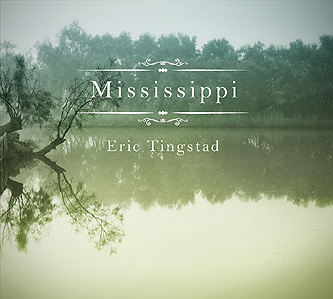 Back
in the 1980’s, guitarist / composer Eric Tingstad rose
to fame during the, then burgeoning Contemporary Instrumental and
New Age music boom. Recording for the Narada Productions label, Tingstad
went on to release a number of albums on Narada between 1987 and 2004.
Perhaps his most popular albums were made with Tingstad & Rumbel,
a duo he formed with woodwinds player Nancy Rumbel and in 2003, Tingstad
& Rumbel’s album Acoustic Garden won a Grammy award.
In 2007, Tingstad released Southwest, a Grammy nominated instrumental
album that features his unique Americana sound. That album was followed
by Badlands and in 2015 Eric Tingstad is back with an all new
Americana flavored instrumental album called Mississippi.
Fans of Tingstad’s impeccable acoustic Americana sound will
love this CD, which is just flowing with a unique blend of instrumental
acoustic guitar sounds that tastefully combines blues, folk, jazz
and even New Age music. Some other comparisons might be to Mark Knopfler’s
earthy instrumental soundtrack flavored music. The album’s focus
is centered on Tingstad’s impressions of the Mississippi Delta
region of the U.S. which has been called the “Cradle Of American
Music.” In fact, there’s a unique instrumental country music
sound on Mississippi too. That country instrumental guitar
sound is brought to life on the all original album with a sweet sounding
cover of the classic “Danny Boy”, which springs to life
here as a toe-tapping 4/4 shuffle. A number of musicians assist Tingstad,
giving the album a solid, lush sound. Commenting on Mississippi,
Tingstad explains, “This is the music I play when I am just
hanging out – open G tuning, the mixolydian mode and some chicken
pickin’. These are my roots and pretty much who I have always
been.” Featuring eleven tracks of guitar magic, Mississippi
is a welcome return from a sometimes underrated, always gifted
American guitar hero. www.erictingstad.com
Back
in the 1980’s, guitarist / composer Eric Tingstad rose
to fame during the, then burgeoning Contemporary Instrumental and
New Age music boom. Recording for the Narada Productions label, Tingstad
went on to release a number of albums on Narada between 1987 and 2004.
Perhaps his most popular albums were made with Tingstad & Rumbel,
a duo he formed with woodwinds player Nancy Rumbel and in 2003, Tingstad
& Rumbel’s album Acoustic Garden won a Grammy award.
In 2007, Tingstad released Southwest, a Grammy nominated instrumental
album that features his unique Americana sound. That album was followed
by Badlands and in 2015 Eric Tingstad is back with an all new
Americana flavored instrumental album called Mississippi.
Fans of Tingstad’s impeccable acoustic Americana sound will
love this CD, which is just flowing with a unique blend of instrumental
acoustic guitar sounds that tastefully combines blues, folk, jazz
and even New Age music. Some other comparisons might be to Mark Knopfler’s
earthy instrumental soundtrack flavored music. The album’s focus
is centered on Tingstad’s impressions of the Mississippi Delta
region of the U.S. which has been called the “Cradle Of American
Music.” In fact, there’s a unique instrumental country music
sound on Mississippi too. That country instrumental guitar
sound is brought to life on the all original album with a sweet sounding
cover of the classic “Danny Boy”, which springs to life
here as a toe-tapping 4/4 shuffle. A number of musicians assist Tingstad,
giving the album a solid, lush sound. Commenting on Mississippi,
Tingstad explains, “This is the music I play when I am just
hanging out – open G tuning, the mixolydian mode and some chicken
pickin’. These are my roots and pretty much who I have always
been.” Featuring eleven tracks of guitar magic, Mississippi
is a welcome return from a sometimes underrated, always gifted
American guitar hero. www.erictingstad.com
mwe3.com presents an
interview with
ERIC TINGSTAD
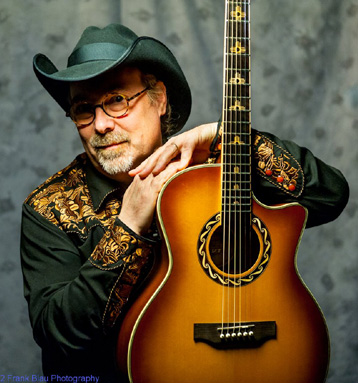 mwe3:
Tell us something about growing up in Seattle Washington, and how
that influenced your musical upbringing. Seattle seems so far up north!
mwe3:
Tell us something about growing up in Seattle Washington, and how
that influenced your musical upbringing. Seattle seems so far up north!
Eric Tingstad: Ah yes, Seattle. The end of the road unless
you're trying to catch a steamer to Alaska. If I had it to do it all
over again I might've moved to someplace like Nashville back in the
mid-1980s. That would've put me more squarely in the populated center
of the United States. We are in a fairly isolated spot from a lot
of touring acts and so we just kinda have to make do with what we
have. On the upside, it does inspire people to create some fairly
unique genres of music.
Seattle was a good market to be part of with the new acoustic movement.
We had great radio support and the culture here resonated with that
genre back then. Other than the new acoustic family that we had here,
the grunge crowd seemed to be a pretty tight knit bunch and seemed
to pull it off okay.
mwe3: Can you remember your first guitars? You were influenced
early on by The Beatles, progressive rock and early instrumental guitarists
like Mason Williams so how did that lead to studying the classical
guitar? I guess “Classical Gas” was responsible!
Eric Tingstad: Well my very first guitar was one that I built
from a piece of plywood and fishing wire. Then my dad pulled one out
of the trash can at work and glued the neck back on. From there it
was just pretty much a series of upgrades until I started playing
Fenders and Ibanez' and Gibsons.
I was 19 years old and had been playing guitar for about 10 years
when somebody asked me to play them a song and other than say playing
the riff from “Layla” or “Whole Lotta Love”, I
was unable to play an entire song. At that time I've also been listing
to a lot of organic jazz like Paul Winter and English art rock groups
like YES and Genesis and was inspired and influenced to learn how
to play a finger style guitar. I realized that the best way to do
that was to go to the university and study classical guitar.
mwe3: Some of your fans are saying that your 2015 CD, Mississippi
is your best album yet. In what ways would you say that Mississippi
is different from and even contrasts with your earlier solo albums,
including your albums with Tingstad & Rumble? Seems like you cover
a lot of musical ground on the Mississippi CD.
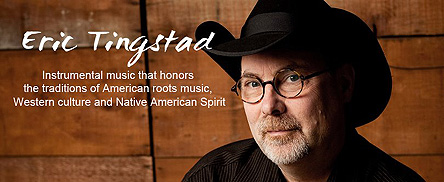 Eric
Tingstad: First and foremost I would say that Mississippi
is a very clear return to my roots as a guitar player and composer
and to the earliest music that I was influenced by and learned.
Eric
Tingstad: First and foremost I would say that Mississippi
is a very clear return to my roots as a guitar player and composer
and to the earliest music that I was influenced by and learned.
There are a couple of ways that a young boy can be influenced by the
blues in the United States. One of them is to actually live in Mississippi
and be inspired by the founders that actually live there and that
you grew up with. The other way to is to learn it through the British
- Eric Clapton, Jimmy Page and Keith Richards. They distilled the
blues and turned it into a pop form that was pretty much the way you
got it if you lived on the West Coast of the United States.
The rootsy music of Mississippi was always underneath most
of the music that I have always done over the years or at the least
the music I really loved. It has been an interesting journey to cull
from inside what it is I am really meant to do.
mwe3: You describe Mississippi as being the kind of
music you play when you’re hanging out and playing in open G
tuning. Can you tell the readers about why you favor the open G tuning,
(mixolydian mode) and how that helps you get that sound and what other
tunings do you use on record?
 Eric Tingstad:
Other than “Long Boats” and “Danny Boy”, I think
that all the songs on Mississippi are done in an open G tuning
with a couple of them being capo’d at the third fret. Jimmy page
used the open G tuning a lot for songs like “Dancing Days”.
Keith Richards, from what I understand, almost uses it exclusively
and you almost have to use it to be able to play “Honky-Tonk
Woman”, “Start Me Up” and “Brown Sugar”.
Eric Tingstad:
Other than “Long Boats” and “Danny Boy”, I think
that all the songs on Mississippi are done in an open G tuning
with a couple of them being capo’d at the third fret. Jimmy page
used the open G tuning a lot for songs like “Dancing Days”.
Keith Richards, from what I understand, almost uses it exclusively
and you almost have to use it to be able to play “Honky-Tonk
Woman”, “Start Me Up” and “Brown Sugar”.
Through the years I have used the open G tuning quite a bit with my
Tingstad and Rumbel recordings. It is also one of the slack key guitar
tunings and it lends itself sometimes to the Hawaiian sound. It's
also the tuning that is used quite extensively on dobro. I find it
to be a very melodic tuning that doesn’t say “Hey, I am
in an alternate tuning.” Other than standard tuning capo’d
at various fret positions, I also use drop D and double drop D. Now
that I think about it, “Chester” on Mississippi is
drop D tuning.
mwe3: Mississippi just grabs your ears right away with
the lead off track “Long Boats”. Did you write “Long
Boats” about something specific? It’s a great way to open
the CD.
Eric Tingstad: Thanks and yes I did. And a lot of people have
offered other insight as to what the song may be about. I wrote this
song to have that “heave ho” kind of propulsion and feel
about it. Long boats were used by the Native Americans here in the
Pacific Northwest and so I learned about that as a young child. But
I also could imagine that there was some variation of that on the
Mississippi River many years ago. Also a Longboat is the name given
to the Viking ships and being Norwegian, I had a connection there
as well. But it was also pointed out to me that the paddle wheel steamships
on the Mississippi were also called longboats so there’s sort
of a triple entendre there.
mwe3: I was going to compare some of Mississippi to
Mark Knopfler’s solo instrumental / soundtrack albums. But unlike
some of those artists, you actually visited the state of Mississippi
when you were younger. How much did that trip influence your music
overall?
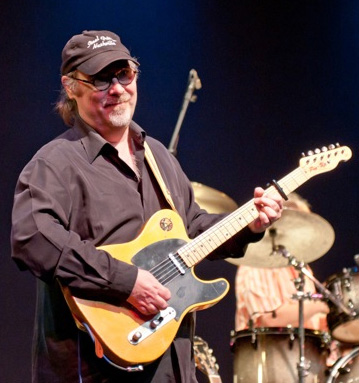 Eric
Tingstad: Most of my music over the years has tended to be inspired
by and about the American landscape and the way the cultures lived
with their landscape, were inspired by it and engaged with it. My
recording Southwest of course, was about the southwest desert
and my trips down there and the CD Badlands was about my trips
and experiences in that kind of geographic region as well.
Eric
Tingstad: Most of my music over the years has tended to be inspired
by and about the American landscape and the way the cultures lived
with their landscape, were inspired by it and engaged with it. My
recording Southwest of course, was about the southwest desert
and my trips down there and the CD Badlands was about my trips
and experiences in that kind of geographic region as well.
But Mississippi has an interesting twist to it in that not
only did the landscape and purpose of the river inspire the music
but also the music from that region that ultimately inspired most
of pop music, ended up in what was going down on the recording as
well. My first trip to Mississippi really set the stage for my influences.
But it was my return trips and hearing and learning more of the music
from the region that kept me on track of having American roots be
the foundation of my style.
mwe3: Speaking of the South, your guitar playing also is influenced
by the great Nashville guitar pickers from Chet onwards. How much
did the guitars sound of Nashville influence you, your guitar style
and the Mississippi album as well?
Eric Tingstad: That question makes me wanna sing “Nashville
Cats” by Lovin’ Spoonful to answer it. There are a few styles
of playing that have emerged from Music City and I have probably been
more influenced by Atkins and Jimmy Reed’s playing than some
of the others. And I would like to get that Brent Mason thing down
a bit more. It just sounds cool! But it’s important to me though
to have a sound that is distinctive and easily identifiable. That’s
what I strive to do. So I don’t spend a lot of time trying to
copy someone or something. I just play what I hear inside and let
it rip.
 mwe3:
Tell us something about the other musicians you picked to play with
you on the Mississippi recording sessions. Is that your set
band when you play concerts?
mwe3:
Tell us something about the other musicians you picked to play with
you on the Mississippi recording sessions. Is that your set
band when you play concerts?
Eric Tingstad: I think that this may be the biggest factor
that determined how this record turned out being a bit more authentic
and singular. Every album that I have done since my very first 2 solo
albums back in the early 1980s - that were actually one solo guitar
- I have incorporated other people to help with the melodic chores.
There was Nancy Rumbel playing woodwinds and then there was Cindy
Cashdollar playing steel guitar and Terry Lauber playing pedal steel
guitar, violin players and a myriad of piano players helping out.
But on Mississippi I decided early on that I was going to be
the sole person responsible for carrying the melodic elements of this
recording. And so this is the smallest group I have employed. But
an ace band for sure. I had my long time bass player Garey Shelton
on about half the tunes and James Clark on the other half. Eric Robert
was the organ player who also played on Badlands. New to the
fold was Chris Leighton who was the obvious choice for that swampy
roots thing. The percussion on this recording is mostly that –
layered percussion as opposed to a trap kit. But sadly we have not
had an opportunity yet to get out and play live together. Hopefully
that will work out soon.
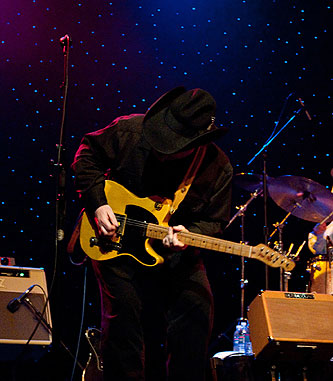 mwe3:
You play all the guitars on Mississippi. What guitars did you
use and which guitars were most prominent on the recording sessions?
Would you consider yourself to be a kind guitar collector / gear head?
mwe3:
You play all the guitars on Mississippi. What guitars did you
use and which guitars were most prominent on the recording sessions?
Would you consider yourself to be a kind guitar collector / gear head?
Eric Tingstad: Again... something a little different, or maybe
back to the way it was, but I used my nylon string classic guitar
to lead the way. I used the Martin New Yorker but not as much as I
have done in the past. The Telecaster and the Strat got lots of work
and I played them with more of that hybrid right hand style and a
bit more Knopfleresque. Not really a guitar collector but I do get
pretty excited about them and amps. I have and used a Dr Z Carmen
Ghia, and I had just picked up a Tone King which is what Knopfler
is known for using. Pretty cool amp!
mwe3: You also play the pedal steel guitar on Mississippi.
What Mississippi tracks did you feature the pedal steel
on and can you contrast your playing the pedal steel with playing
other guitars? What are your favorite pedal steel guitars to play?
Eric Tingstad: Yes, I did handle all the pedal steel chores
on Mississippi. The biggest showpiece for that would be “Danny
Boy”. I kinda forced that one on the record. It’s a bit
different than the other songs. But I have had great response and
feedback about it so I guess it works. A lot of people will tell you
that the pedal steel is hard to play. For some reason it makes a lot
of sense to me and I find it easy to play in a modest fashion. I am
not a slinger for sure but I coax the music out of it somehow. I think
my classical background and math aptitude help out. It really is a
machine based on matrices and determinants. Just play it in tune and
you are good to go because it is such a beautiful sounding instrument.
A little bit goes a long way. I have a very sweet 1973 ShoBud 6139
single neck.
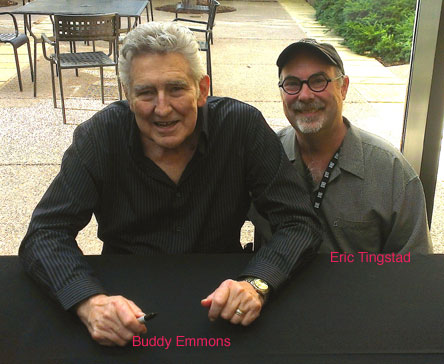 mwe3:
Did you do a lot of guitar overdubs and multi-tracking on Mississippi
or was it mostly cut live in the studio? Can you also tell us
something about your recording studio and who helped you get such
a great studio sound on the Mississippi CD?
mwe3:
Did you do a lot of guitar overdubs and multi-tracking on Mississippi
or was it mostly cut live in the studio? Can you also tell us
something about your recording studio and who helped you get such
a great studio sound on the Mississippi CD?
Eric Tingstad: It was serious overdub city. No two players
were ever together in the studio at the same time! (lol)
My studio is a very modest one room facility with a couple of sweet
pre amps and a few really good mics. All I have to do is get a good
sound and performance down and then I hand the project off to my very
able mixing engineer Tom Hall. Tom and I have been working together
for a very long time. The cool thing is Tom treats each project on
its own merits and so it’s not a cookie cutter kind of approach.
I have a lot of fun having someone else mix. Tom does it without me
with him until the final tweaks. He spends a lot of time on it.
mwe3: Would you say there’s also a kind of New Age vibe
on Mississippi, especially as so much of it is so relaxing
and even meditative? I’m thinking of track four, “Trail
Of Tears”, which is so deep sounding. Would you say “Trail
Of Tears” is a guitar lovers dream come true?
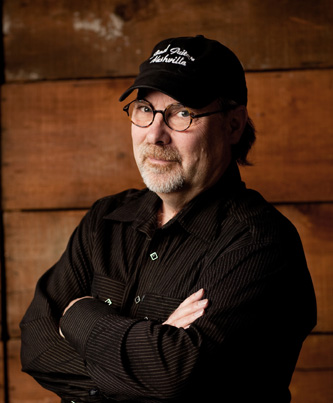 Eric
Tingstad: I would have to say no on the New Age thing. Or at least
not much as that is not what I was going for. “Trail Of Tears”
is a very emotional piece of music, given the subject matter, and
I really appreciate it that you and others pick up on that. Thanks!
But, I really don’t listen to what folks call New Age. It kinda
has the opposite effect on me and makes me wanna go postal or something.
I’ll take a good old depressing song from like say Lucinda Williams
any old day. Or a slammin’ AC/DC rocker. The GRAMMY submissions
board put Mississippi in the Americana category, which was
great by me and actually flattering.
Eric
Tingstad: I would have to say no on the New Age thing. Or at least
not much as that is not what I was going for. “Trail Of Tears”
is a very emotional piece of music, given the subject matter, and
I really appreciate it that you and others pick up on that. Thanks!
But, I really don’t listen to what folks call New Age. It kinda
has the opposite effect on me and makes me wanna go postal or something.
I’ll take a good old depressing song from like say Lucinda Williams
any old day. Or a slammin’ AC/DC rocker. The GRAMMY submissions
board put Mississippi in the Americana category, which was
great by me and actually flattering.
mwe3: What other projects are you currently involved with,
especially as I know you often open up your recording studio to other
artists? Do you enjoy doing production and session work as much as
writing and recording as a solo artist?
Eric Tingstad: I don’t have any other outside recording
projects going on right now. I am deeply into songwriting and that
whole world which has been a big inspiration and has affected my instrumental
composing.
I am on the lookout for a couple new singers to work with however.
Someone whose voice compliments my sound on Mississippi and
can co write and does not come with a whole lot of strange baggage.
Or maybe we need all that strange baggage to get to the root of it
all.
mwe3: Have you given a lot of thought to what kind of musical
directions you’d like to go in next? Have you any new writing,
recording, producing or touring planned for the remainder of 2015
and into 2016?
 Eric
Tingstad: I have a few new pieces that are in that bluesy Americana
roots world of Mississippi open G tuning that I will record
in a live situation early next year. Most likely with the band from
the CD. Until then I’ll be performing holiday shows based on
my early recordings with Tingstad and Rumbel.
Eric
Tingstad: I have a few new pieces that are in that bluesy Americana
roots world of Mississippi open G tuning that I will record
in a live situation early next year. Most likely with the band from
the CD. Until then I’ll be performing holiday shows based on
my early recordings with Tingstad and Rumbel.
I am however thinking about where I wanna go next geographically.
Kinda thinkin’ Florida and the Keys...



